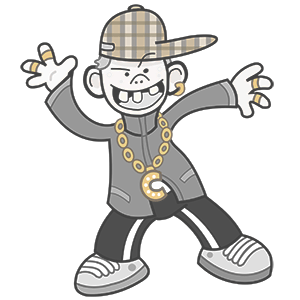Speed Golf is a sport started in California in 1979 by American runner Steve Scott and which involves completing a golf course in the lowest combination of strokes and time. Players run between shots and generally carry one to six clubs. A player’s score is calculated by adding minutes plus strokes, so a round of 90 completed in 50 minutes and 30 seconds would compute to a score of 140:30. The lowest score in competition is believed to have been shot by professional Christopher Smith at the Chicago Speedgolf Classic in 2005. Smith shot 65 in just 44:06 for a speed golf score of 109:06.
Rules and etiquette are generally the same for speed golf and regular golf with minor exceptions. Speed golfers are allowed to putt with the flagstick left in the hole, but are expected to rake bunkers, fix ball marks and conform to the dress code. Speed Golf is sometimes contrasted with Cross-country BigBall, in which players use soccer balls and baseball bats. Both sports require substantial physical stamina.
Speed Golf
Prole Drift
Prole drift, short for proletarian drift, is a trend in which products, styles or other aspects of culture previously considered to be upscale or upper class become popular among working class people. Prole drift can also go the other way, as when things that were once the purview of the working class become fashionable in the middle or upper classes. The term was coined by, American literary historian, Paul Fussell in 1983 to describe the phenomenon of most aspects of high culture eventually joining the lowest common denominator.
Examples include sales of premium coffee, Burberry clothing or Coach Inc. handbags to working class people. Examples of reverse prole drift include Mockney, the skinhead and punk subcultures, hip hop, rockabilly, dressing down, slumming it (e.g. going to a working class bar) and NASCAR. BMW cars (particularly the 3 series) have also suffered from this phenomenon, in some instances the 3 series outselling more mainstream cars such as the Ford Mondeo and Vauxhall Vectra.
Popped Collar
An upturned collar (or popped collar) is an otherwise flat, protruding collar of either a shirt, jacket, or coat that has been turned upward. Before the early 20th century, most shirt collars were turned up in some manner. Men and women alike wore tall, stiff collars (as much as three inches tall), not unlike a taller version of a clerical collar, made either of starched linen, cotton, or lace. The writer H. G. Wells remarked in his 1902 book ‘Kipps’ that these ‘made [the] neck quite sore and left a red mark under [the] ears.’
Between the late 19th and mid-20th centuries, men’s collars were often detachable from their shirts, connected only by two removable collar studs (one in front and one in back). Detachable collars were very stiff, and either stood straight up (Hamilton collar) or were pressed over at an ironed-in, starched crease (Fremont collar). After WWII, mass-production gradually phased out detachable collars from ordinary dress shirts. Occasionally, one can still find detachable collar formal shirts, designed to be worn with a tuxedo or evening dress.
read more »
Chav
A chav is a stereotype of certain people in the United Kingdom. Also known as a charver in Yorkshire and North East England, ‘chavs’ are said to be aggressive teenagers, of white working class background, who repeatedly engage in antisocial behaviour such as street drinking, drug abuse and rowdiness, or other forms of juvenile delinquency. The derivative Chavette has been used to refer to females.
Chav probably has its origins in the Romani word ‘chavi,’ meaning ‘child’ (or ‘chavo,’ meaning ‘boy,’ or ‘chavvy,’, meaning ‘youth’). This word may have entered the English language through the Geordie dialect word charva, meaning a rough child. This is similar to the colloquial Spanish word chaval, meaning ‘kid’ or ‘guy.’ In Italy, chavs are termed as coatto, which basically means ‘working class’ and vulgar.
read more »
Music for Airports
‘Ambient 1: Music for Airports‘ is an ambient album by Brian Eno released in 1978. Of four albums released on Eno’s own, then new, Ambient label, ‘Music for Airports’ was the first to carry explicitly the name ‘ambient’ – a term which he coined to differentiate his minimalistic approach to the album’s material and ‘the products of the various purveyors of canned music.’ Notice of similarly quiet, unobtrusive music had been given on his albums such as ‘Evening Star,’ ‘Discreet Music,’ ‘Music for Films,’ and Harold Budd’s ‘The Pavilion of Dreams’ (which Eno produced), but in this album it was given precedence as a fully developed concept.
The music was designed to be continuously looped as a sound installation, with the intent to defuse the tense, anxious atmosphere of an airport terminal. Eno conceived this idea while being stuck at Cologne Bonn Airport in Germany in the mid 70s. He had to spend several hours there and was extremely annoyed by the uninspired sound atmosphere. It was installed at the Marine Air Terminal of New York’s LaGuardia Airport.
Content Farm
In the context of the World Wide Web, content farms are companies (or their divisions) that employ large numbers of (often freelance) writers to generate large amounts of textual content. The articles in content farms are written by human beings but may not be written by a specialist in the area. In one of Google’s own promotional videos the majority of the links available were actually produced at content farms.
Content farms contain huge number of articles. For instance, Demand Media will soon be publishing 1 million items a month, the equivalent of four English-language Wikipedias a year. Big content farms are expensive resources, sold for many millions.
read more »
Fad
A fad, sometimes called a trend, meme or a craze, is any form of behavior that develops among a large population and is collectively followed with enthusiasm for some period, generally as a result of the behavior’s being perceived as novel in some way.
A fad is said to ‘catch on’ when the number of people adopting it begins to increase rapidly, but they fade quickly once the perception of novelty is gone. Though the term trend may be used interchangeably with fad, a fad is generally considered a fleeting behavior whereas a trend is considered to be a behavior that evolves into a relatively permanent change.
read more »
Monty Hall Problem
The Monty Hall problem is a famous problem in probability science. The problem is based on a game show, ‘Let’s Make a Deal,’ and is named for the show’s host, Monty Hall. In the problem, there are three doors. A car is behind one door and goats behind the other two doors.
read more »
Happy Slapping
Happy slapping is a fad in which someone assaults an unwitting victim while others record the assault. The ease and general availability of video cameras in mobile phones means that such attacks need not be planned carefully beforehand and are more easily watched and circulated for comedy purposes afterwards.
The practice started in the South London London Borough of Lewisham. Initially the attacks were, as the phrase would have us believe, fairly minor pranks … As the craze spread the attacks became more vicious – often serious assaults known in British legal circles as grievous bodily harm.
Robot Jockey
A robot jockey is commonly used on camels in camel racing. Early designs confused or frightened the camels, so the robots were modified to include more human-like features, including a mannequin-like face, sunglasses, hats, racing silks and even traditional perfumes used by human jockeys. Developed since 2004, the robotic jockeys are slowly phasing out the use of human jockeys, which, in the case of camel racing in the Middle East, often employs small children who reportedly suffer repeated systemic human rights abuses. In response to international condemnation of such abuses, the nations of Qatar and the UAE have banned the use of human jockeys in favor of robots.
Camel racing has been around for thousands of years. ‘The Sport of Sheiks’ almost exclusively utilized small children, usually boys around the age of four, to ride and direct the camels. Often, the boys would be starved to be as light as possible. Many of the boys used for the races were often sold to race organizers or camel owners, and there was an active child slave trade for camel jockeys, involving victims of kidnapping or the children of destitute families who sold them into servitude.













